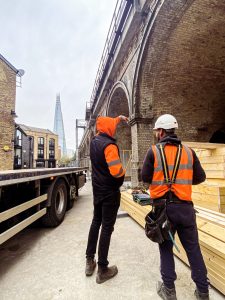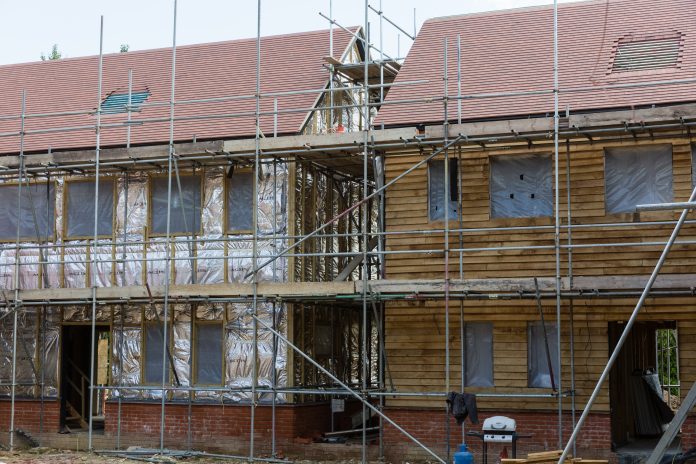Paramount Timber Group explores the obstacles to mass timber frame adoption and how they can be overcome
Increased use of wood as a building material is vital if the government is to meet both its housebuilding targets and its climate change commitments. That’s the verdict from a white paper published by the Structural Timber Association (STA) in March.
But, from an industry poll by the insurance body NHBC, fewer than three in 10 housebuilders plan to use timber frame, even with the knowledge it reduces carbon footprints like no other building material.
Timber frame construction has unclear government guidance
It seems the core reason is unclear government guidance, which is resulting in fear of reprimand.
The government is happily promoting the use of renewable materials for the sake of the environment but at the same time, it’s discouraging flammable materials. Confusing.
In the wake of the Grenfell tragedy, there has been a ban on the use of combustible materials for external walls of 18m or more in height. That’s crystal-clear instruction. It gets a little hazy after compliance with this rule, though. If using timber for less than 18m high external construction, the ‘rule’ is the materials must meet the “functional requirements” of the Building Regulations.
And those regulations start with the statement: “The building shall be designed and constructed so that, in the event of fire, its stability will be maintained for a reasonable period”. Not so clear. And it’s certainly not specific enough guidance to be building with any level of confidence or assurity.
Timber frame construction is feared, especially the perceived fire risk
Understandably, there’s a strong fear around committing to timber when it’s unclear whether how it is constructed – no matter how careful, comprehensive and particular the processes and plans are – is in line with the rather vague policies and guidance.
And tragic events such as Grenfell exacerbate these fears. They have already influenced views on certain materials; for one, timber has been tarred with the same brush applied to cladding.

Perceived fire risk is clearly the key reason why many are reticent about using timber for building projects. And it seems this is a shared perspective, within the industry and from the government – proven by the vagueness of the latter’s guidance.
This isn’t necessarily a universal issue, though – other countries are not experiencing the same friction and lack of alignment.
But timber surpasses the performance of concrete or steel at high temperatures.
Ian Fletcher, the director of policy at the British Property Federation, has noted that: “Timber is used more widely in construction around the world, where there is a tight regulatory regime and often a requirement for other suppression measures, such as sprinklers.”
Fletcher has also exposed what needs to happen for us to hit our environmental goals with timber “…for it to be used at scale, there will need to be additional testing and tighter regulations.”
The scale of this task is laid bare by Geoff Wilkinson, managing director of Wilkinson Construction Consultants and an approved inspector.
“The construction industry has not got its head around the need for large-scale testing,” he says. “The accuracy and reliability of test data has been scrutinised in the Grenfell Inquiry. We should have progressed 10 years ago with the scale of tests necessary to justify the use of timber.”
So, from looking at the evidence so far, it seems the government is probably being cagey around setting boundaries because the data to back it up is not available to justify hard and fast rules.
But the call for timber frame adoption is not going away. It’s in huge demand for many reasons, not least its environmental benefits and the favourable modern aesthetic it offers.
If the obstacles in the shape of proper guidance and rules are not overcome soon, the supply and demand bottleneck will turn into a complete blockage. That’s when real pressure will build, so it’s in the policymakers’ interest to act decisively sooner rather than later.
Building timber confidence with the adoption of MMC
One way to build more confidence and assurance – for all parties – is to further embrace Modular Methods of Construction (MMC). These forward-thinking techniques are already increasingly favourable, and they certainly support the scrutiny required to fully embrace timber frame construction.
A key benefit of MMC is enforced quality control. Within offsite factory environments, more detailed and in-depth safety checks can be performed. This will help to make sure industry standards and performance levels are met (including fire safety requirements).
Is timber more flammable?
The fire risk around timber is a ‘perceived risk’. That’s because timber isn’t necessarily more flammable than other materials. Seriously. Other countries aren’t using it more because they are less cautious. They’re using it because they’re more clued in and don’t have a cultural hang-up over the material.
In the UK, it seems we have a psychological barrier when it comes to timber and the risk of fire. But timber surpasses the performance of concrete or steel at high temperatures.
Also, the safety of timber can be improved even more when it’s treated with specialist flame retardant.
With the right legislation, and the correct safety and quality control checks, timber is the optimal material for the construction of a variety of structures.
The quicker this is realised and supported, the faster we can meet the demands of our customers and our planet.
Richard Swayne
Managing Director
Paramount Timber Group
Tel: +44 1634 893 821
Please note: this is a commercial profile

















